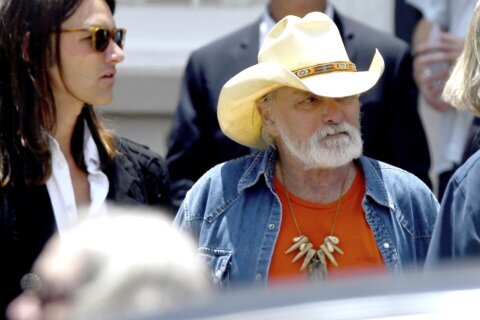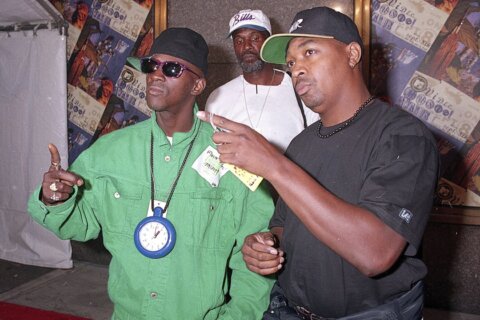WASHINGTON — He’s one of the finest actors of his generation, consistently ahead of the curve by picking projects with the most visionary of filmmakers.
Surely, there would be no “Requiem for a Dream” (2000) without his “Trainspotting” (1996) nor an entire era of musicals (“Chicago,” “Dreamgirls,” “Les Mis”) without his “Moulin Rouge!” (2001).
Did we mention he was also Obi freakin’ Wan?
Now, Ewan McGregor attempts to do it again with Rodrigo Garcia’s “Last Days in the Desert” (2016), now playing in limited release at Landmark Bethesda Row. The film explores the Biblical tale of Jesus fasting in the desert for 40 days, while grappling with The Devil over the fate of a family in crisis.
“[We] invented a story within that period when Jesus was in the desert, which isn’t really covered very much in The Bible,” McGregor told WTOP. “There’s not a great deal written about it.”
Making the project even juicier is that McGregor plays both Jesus and Lucifer. If this were Ingmar Bergman’s “The Seventh Seal” (1957), Max von Sydow would be playing chess against himself. As the Rolling Stones sang, “As heads is tails, just call me Lucifer,” suggesting two sides of the same coin.
“I [was] very daunted by playing Jesus … and thinking about how to portray somebody who’s known personally in a very deep way by so many people in the world,” McGregor said. “Then I realized once we got down there in the desert … that I hadn’t given The Devil very much thought at all. But he seemed to come a little bit more naturally to me anyway. I don’t know what that tells you about me.”
Joking aside, the prospect of playing Christ is daunting no matter the angle. Do you go traditional like William Wyler’s “Ben-Hur” (1959), Nicholas Ray’s “King of Kings” (1961) or George Stevens’ “The Greatest Story Ever Told” (1965)? Do you disguise it like Carl Theodor Dreyer’s “Ordet” (1955)? Do you spark controversy like Martin Scorsese’s “The Last Temptation of Christ” (1988)? Or do you infuse violence to become brutally bludgeoned like Mel Gibson’s “The Passion of the Christ” (2004)?
Arguably the closest depiction remains Pier Paolo Pasolini’s “The Gospel According to St. Matthew” (1964), painting Jesus Christ as a Pope Francis-style marxist avant-la-lettre (before you scoff like some Pharisee, think of Jesus turning over the money tables in the temple and it makes total sense).
Amid so many past portrayals, McGregor said it was important to take his own unique approach, namely trying to forget that it was even about Jesus at all and instead focus on the parental themes.
“We never ever set out to make a gospel movie. We didn’t set out to make a film about Jesus. That wasn’t the point,” McGregor explained. “What we did was set out to make a film about the exploration of this parental-child relationship, and the leading figure just happened to be Jesus.”
It’s a deeply personal theme for Colombian-born writer/director Rodrigo Garcia, son of the late filmmaker Gabriel García Márquez (“Jose and Pilar,” “Love in the Time of Cholera”), who died in 2014.
“It’s really a film about fathers and sons,” McGregor said, pausing to send his daughter to school.
“Rodrigo had a very powerful father … and I’m not suggesting he wrote about his own relationship [strictly autobiographically], but the relationship between a son and a very powerful father. And he ended up writing just about the biggest and most powerful one of all, which was Jesus and God.”
Film by film, Garcia has built his own legacy in his own right: “Nine Lives” (2005), starring Kathy Baker, Glenn Close and Robin Wright, “Mother and Child” (2009), starring Naomi Watts, Annette Bening and Kerry Washington, and TV’s “Blue” (2012), starring Julia Stiles and Kathleen Quinlan.
“He’s a really brilliant filmmaker,” McGregor said. “He’s made choices to make the films he makes and keep control of them and isn’t a director for hire, but really a director as an artist.”
In “Last Days,” Garcia reunites with his old friend Emmanuel “Chivo” Lubezki, who’s won the Best Cinematography Oscar the past three years: “Gravity” (2013), “Birdman” (2014) and “The Revenant.”
“I know Chivo, our kids go to the same school,” McGregor said. “I like his style. … We had some night scenes around a campfire, so there were a few lights, but really we were in the middle of a desert so we couldn’t drive [gear] in. … During the day, he really only used available light … It was just amazing to watch his artistry and how important it was to be shooting in the right light at the right time.”
As the sun entered its optimal location, the actors had to be ready to roll in small windows of time.
“We would be there at 4:30 in the morning waiting for the sun to come up, and then we’d try to shoot a scene in that light just as the sun was coming up,” McGregor said. “So it was really interesting the impact that his work, his expertise had on the actual shooting of the film. It was hand-in-hand.”
McGregor is no stranger to talented filmmakers. His body of work is filled with visionaries: Todd Haynes’ “Velvet Goldmine” (1998), Ridley Scott’s “Black Hawk Down” (2001), Tim Burton’s “Big Fish” (2003), Marc Forster’s “Stay” (2005), Michael Bay’s “The Island” (2009), Mike Mills’ “Beginners” (2010), Lasse Hallström’s “Salmon Fishing in the Yemen” (2011), J.A. Bayona’s “The Impossible” (2012), John Wells’ “August: Osage County” (2013) and Don Cheadle’s “Miles Ahead” (2016).
But of all of these filmmakers, WTOP asked McGregor to contrast the styles of his three most famous flicks. First and foremost, there’s the British masterpiece “Trainspotting” (1996), directed by Danny Boyle, who also cast McGregor in “Shallow Grave” (1994) and “A Life Less Ordinary” (1997). No one will ever forget the film’s drug-addict trips of falling through floors and babies crawling on ceilings.
“Danny was my first director,” McGregor said. “[He] rehearsed with the actors alone on set. [He] would bring the D.P. in and then [he] would show the crew before we shot it. … He encourages you to have something to aim for in every take. He doesn’t just say, ‘One more,’ he’s giving you things to reach for. As an actor, that’s very satisfying. You come home feeling like you’ve done your best work.”
After proving his gritty, head-shaven, drugged-out side, McGregor did a 180 and earned a suave Golden Globe nod in the lavish musical “Moulin Rouge!” (2001). If you doubted his pipes, just listen to him belt the “Elephant Love Medley,” “Your Song” and “Come What May” alongside Nicole Kidman, as director Baz Luhrmann pulls out all the stops, including flipping his camera upsidedown across Paris.
“Baz definitely [is] a wonderful fantasist and a great imaginator and a wonderer,” McGregor said. “I loved his spirit that anything’s possible. I loved working with him very much. Again, there’s something about his exploring through takes, encouraging you to keep searching for different flavors in a scene.”
Then, of course, there’s his most notable blockbuster, “Star Wars: Episode I – The Phantom Menace” (1999), the first of three “Star Wars” prequels directed by George Lucas. Not only was McGregor given the esteemed honor of playing the younger version of Alec Guinness’ Obi-Wan Kenobi, he got the chance to work with Lucas, a pioneer of digital effects and an epic dreamer of faraway worlds.
“George is a different ballgame because it was so technical,” McGregor said. “The ‘Star Wars’ films were a very technical exercise. I don’t think I would make a film like that myself, a green screen type.”
So what type of film would McGregor choose to make? Oh wait, he already has.
Behold, his feature film directorial debut “American Pastoral” (2016), starring McGregor, Dakota Fanning, Jennifer Connelly, Molly Parker, Uzo Aduba, Rupert Evans and David Strathairn. Based on a novel by Philip Roth, the drama is set in postwar America, as a man watches his seemingly perfect life fall apart thanks to his daughter’s new political affiliation. The film is set for release on Oct. 28.
After that, get ready for the 2017 release of the anticipated sequel “Trainspotting 2,” for which McGregor is reuniting with Boyle in a production that begins two weeks from now in Scotland.
“Although I worked with him 20 years ago, he sort of taught me how I think it’s done best.”
Ewan, you’ve taught a lot of us how it’s done best.
Click here for more info on “Last Days in the Desert.” Listen to the full interview with Ewan McGregor below:








